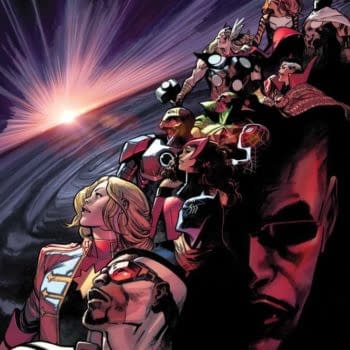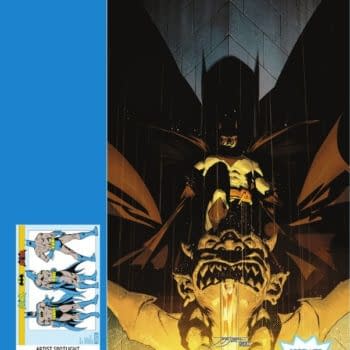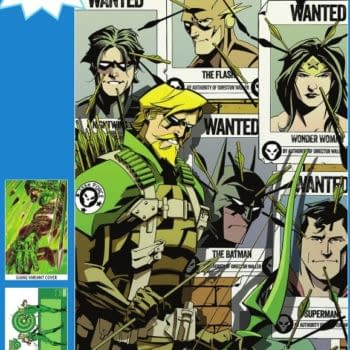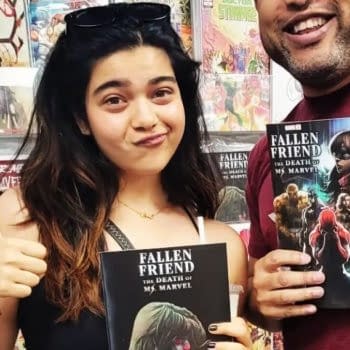Posted in: Comics | Tagged: Comics, dc, dennis o'neil, denny o'neil, how to write comics and graphic novels, How to write comics and graphic novels by Dennis O'Neil, marvel, MVL
How To Write Comics And Graphic Novels by Dennis O'Neil #17 – Making Pictures

A lot of major movies are getting pretty uppity these days. They're not content to fill up the screens of your local jumboplex—oh no, not these entertainments. They insist on also being novels, video games and…yes, comic books.
Which means that we comic folk occasionally get jobs that involve adapting material from one medium to another. You will not be surprised to learn that we will, today, examine only one variety of these presto-changos..
So: going from a film script to a comic book.
This can be an educational experience because it forces you to look at another writer's structure, pacing, scene placement, exposition, and so on and so forth…
The first thing to be aware of is that the task is one of translation. Like someone translating a poem from language A to language B, you've got to rethink the material in your own idiom. Though they're both visual media, a movie is not a comic book—far from it–so you've got to express the story and ideas of the film in the unique language that is comics.
Ideally, you'd rethink the movie's story in comics form—start as though you're doing a totally original story. But, in the gritty arena of real-life publishing, we seldom have this option. The client—the movie guy—wants his creation put on a page, and maybe the person who eventually buys your comics might want a souvenir of a good afternoon at the jumboplex. So…rethink when and where necessary.
But meanwhile…
A film script is about 120 pages, more or less. I've never worked on an adaptation in which I was allowed more than 56 pages. Obviously, a lot has to be cut.
Where to begin…?
First, read the movie script carefully and define what the story is about—locate that spine we've discussed in earlier installments of this whatever-it-is. You might find subplots that, while interesting in themselves, have little bearing on the main plot. You'll probably want to give them the axe. Then choose which scenes are important—which ones "stick to the (aforementioned) spine; be certain that these scenes incorporate all the major plot points. Next, decide which lines of dialogue and bits of action within your scenes are important. Put all this into your comic book script and…
Oh, dear. Still too much movie for your 56 pages? Okay, now compress action scenes–fights and chases. Though comics can do combat well, they're often a tad deficient in that staple of film earlier days. So decide what the chases and fights accomplish in terms of the plot, then put in just enough of the action to do the plot work. Does the chase exist to get the hero from this point to that point. Okay: the chase takes 10 minutes of screen time and a primo ten minutes they are, real edge-of-the-seat stuff. But as far as the plot's concerned, they do no more than move Mr. Hero to where he has to be. So, with your movie-going heart breaking, you can shrink the chase to a few panels. Similarly, with fights: a well-choreographed martial arts encounter sets the child's soul inside my ancient body a'twitter. But, in plot terms, what does the battle accomplish? Demonstrate the hero's prowess? Indicate who his enemies are? Provide an obstacle for him to overcome? Fine: put enough in to establish what has to be established.
You still might not be done. You might have to alter your pacing—add panels to pages, maybe. Or rearrange them. Switch dialogue from one character to another (provided that the dialogue in question isn't overly idiosyncratic. You don't want Queen Elizabeth taking like the Hulk.) Do some fussing around.
Finally: You may have to write some transitional captions or other kinds of bread-and-potatoes stuff. Remember that, although an adaptation, your story should be well and clearly told. Then act appropriately.
Dennis O'Neil teaches a ten week course on Writing Comics And Graphic Novels at the New York University. Classes are every Wednesday evening from 6.45pm to 9pm. For further information, please call NYU's School of Professional and Continuing Studies at Studies at 212 9987200












